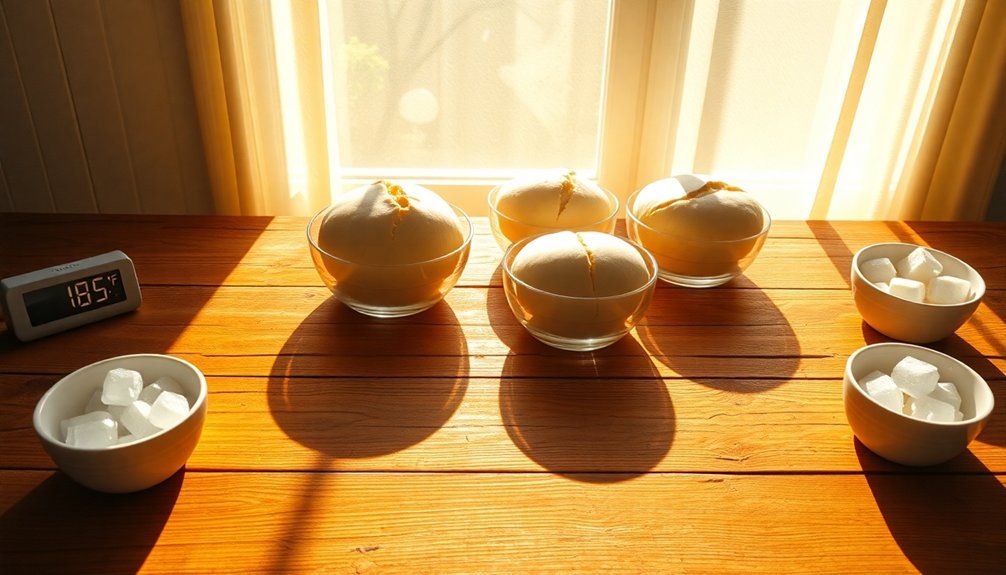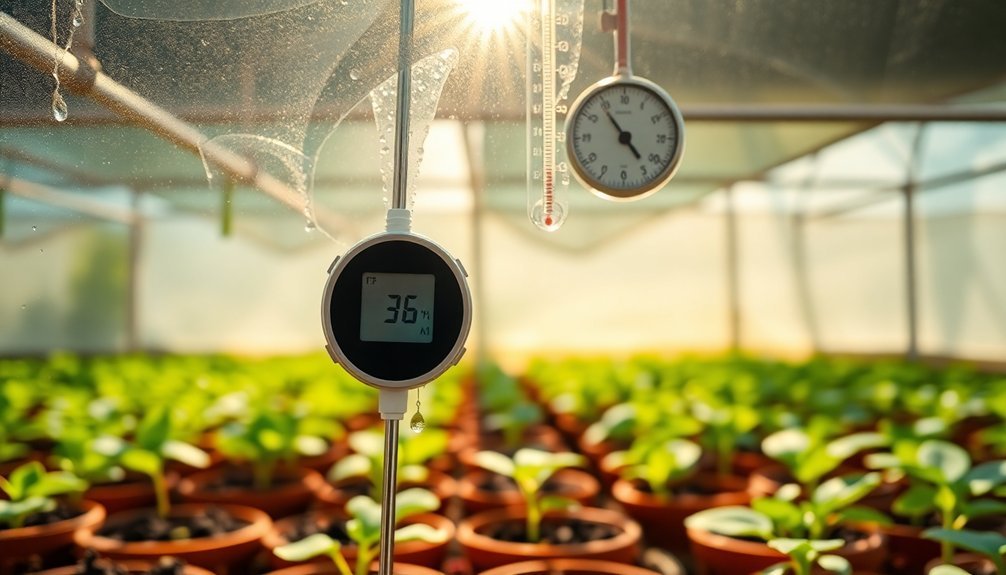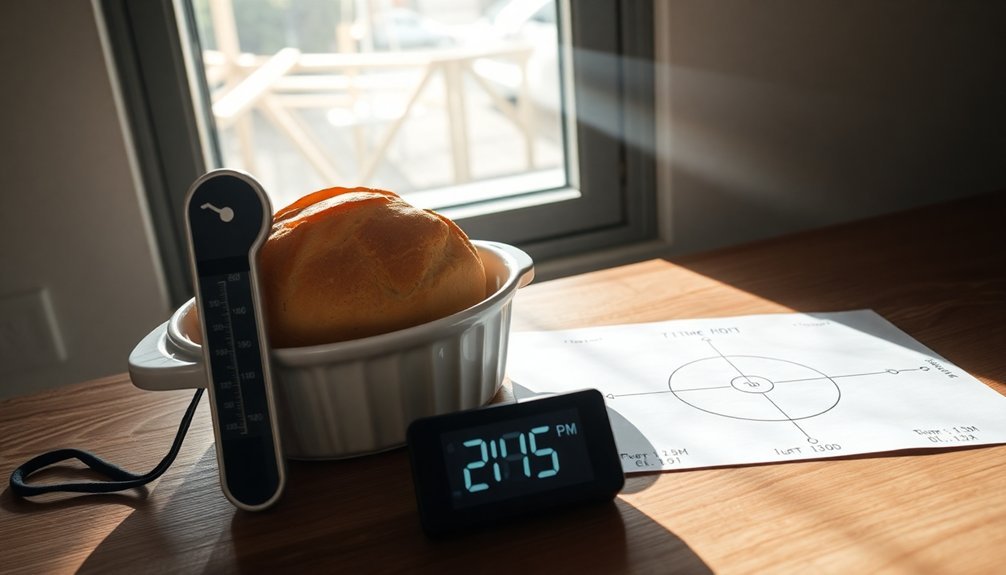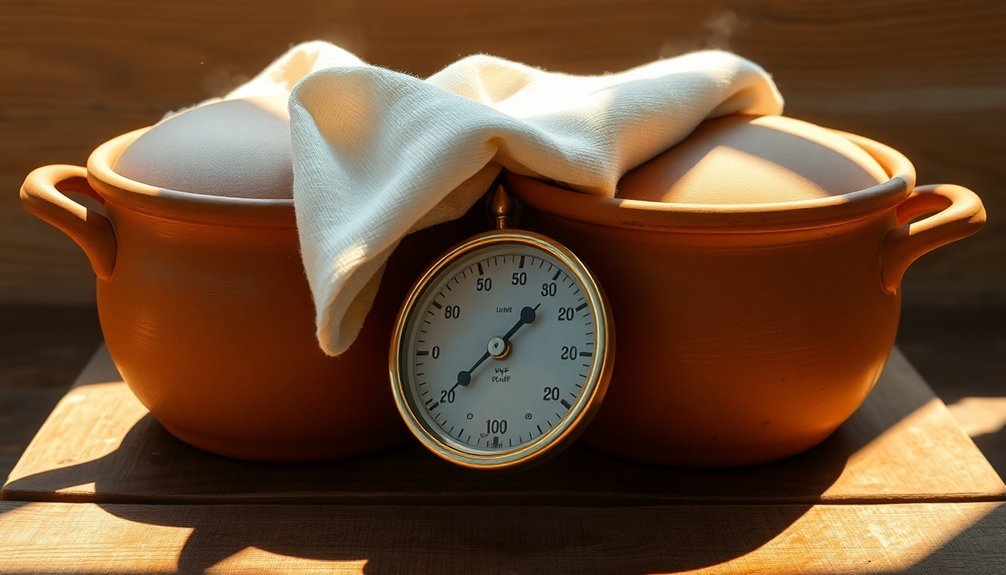For successful sun baking, you'll want to maximize direct sunlight exposure during morning hours or after 3 p.m. to avoid intense UV rays. Adjust your oven's position every 30 minutes to maintain peak temperatures, especially during winter months when the sun sits lower. Keep track of weather patterns using temperature and humidity sensors to guarantee ideal baking conditions, and protect your setup from wind and debris. In cold seasons, use proper insulation techniques like thermal drapes and weather stripping to retain heat. Monitor your solar oven's temperature gauge and add 15-30 minutes to conventional recipe times when temps fall below 300°F. These foundational tips just scratch the surface of mastering solar cooking.
Maximize Direct Sunlight Exposure

Three key factors determine the effectiveness of direct sunlight exposure: timing, duration, and skin protection.
For ideal results, you'll want to avoid peak hours between noon and 3 p.m. when UV rays are strongest. Instead, schedule your sun time during morning hours or after 3 p.m., especially if you have fair skin.
To maximize your exposure safely, position yourself where you'll receive unobstructed sunlight and rotate your body regularly for even coverage. Despite conventional advice, midday sun is actually when your body produces vitamin D most efficiently.
Wear strapless clothing to minimize tan lines, but don't forget to apply a full ounce of SPF 30 sunscreen 20 minutes before heading outside.
Monitor your time carefully – stay out for only half the duration it typically takes your skin to burn.
Take regular shade breaks and stay hydrated throughout your session.
Seasonal Positioning Adjustments
As the seasons change throughout the year, you'll need to make specific adjustments to your sun oven's position to maintain ideal cooking temperatures.
During winter, use the T-leg to capture the lower sun angle, and in higher latitudes, lay the oven on its back for better efficiency. You'll need to adjust the position every 30 minutes to maintain heat.
Summer offers more flexibility, as you won't need to raise the leg as often unless cooking early or late in the day. You can expect up to 13 hours of cooking time in southern latitudes during June. The built-in notch system makes these seasonal position changes quick and simple to execute.
Spring and fall require more frequent positioning adjustments due to the sun's lower horizon position. For all seasons, use the E-Z sun-track indicators for perfect alignment, and plan your cooking between 11:00 am and 3:00 pm for optimal outcomes.
Weather Pattern Monitoring

Successful sun baking relies heavily on accurate weather monitoring systems. You'll need to track various atmospheric conditions to achieve ideal results. Modern sensor arrays can help you collect essential data about temperature, humidity, wind speed, and solar radiation levels – all vital factors for effective sun baking.
- Use temperature and humidity sensors to maintain perfect conditions for your sun-baked goods.
- Monitor wind patterns through anemometers to protect your items from unwanted debris.
- Track solar radiation intensity to determine the best exposure times.
- Leverage barometric pressure readings to anticipate weather changes that might affect your baking.
Consider using cloud-based platforms like Envizom to receive real-time alerts and insights. These systems can help you make quick adjustments to protect your sun-baked items when weather conditions suddenly change. For reliable backup during internet outages, your monitoring system should include microSD card storage to prevent data loss.
Insulation During Cold Seasons
While sun baking thrives in warmer months, proper insulation becomes essential for maintaining consistent temperatures during cold seasons.
You'll want to focus on sealing your windows with weather-stripping and clear plastic insulation to prevent heat loss. Adding thermal drapes that you can open during sunny hours and close at night will help regulate temperature fluctuations.
Don't overlook your walls and ceiling, as they're prime areas for heat escape. Install fiberglass insulation sheets and guarantee your ceiling is well-protected.
For the floor, lay down carpets or rugs to minimize heat loss through the ground. To maximize warmth retention, install a ceiling fan to recirculate rising heat, and consider using a portable space heater to warm the area before your baking sessions.
Optimal Baking Time Selection

Selecting the ideal baking time for solar cooking requires careful consideration of multiple variables, from weather conditions to recipe requirements.
You'll need to monitor your solar oven's temperature gauge closely, as internal temperatures can fluctuate between 250-350°F depending on sunlight and weather conditions.
- Start with conventional recipe times as a baseline, but be prepared to add 15-30 minutes when temperatures drop below 300°F.
- Check your food at the minimum suggested cooking time, then adjust based on doneness.
- Factor in a 10-15 minute extension each time you open the oven door.
- Plan for longer cooking times during winter months or on cloudy days.
Remember to position your oven away from wind and regularly adjust its angle to follow the sun's movement for consistent temperatures throughout the baking process.
Frequently Asked Questions
Can I Use Aluminum Foil to Increase Heat Reflection Inside the Oven?
Yes, you can use aluminum foil to boost heat reflection inside your oven. Line the interior with foil and create a reflector panel outside to direct more sunlight in, increasing cooking temperatures considerably.
How Do Temperature Fluctuations Affect Rising Dough in Sun Baking?
When you're sun baking, temperature changes can drastically affect your dough's rise. You'll notice faster fermentation in warmer spots, slower in cooler areas, which can lead to uneven rising and inconsistent results.
What's the Ideal Internal Temperature for Sterilizing Jars in a Sun Oven?
You'll need to maintain at least 160°C (320°F) in your sun oven for proper jar sterilization. For best results, aim for 180°C (356°F), but don't exceed this temperature to prevent potential glass damage.
Does Altitude Affect Cooking Temperature and Time in Solar Ovens?
Yes, when you're at higher altitudes, you'll experience hotter temperatures and faster cooking times in your solar oven. This happens because there's less atmosphere blocking the sun's rays, resulting in more intense solar radiation.
Should I Adjust Recipe Temperatures When Converting From Conventional to Solar Baking?
Yes, you'll need to adjust temperatures when converting recipes. Double your cooking time if your solar oven runs cooler than conventional temperatures, and monitor closely with a thermometer for accurate results and adjustments.
In Summary
You'll get the best results from sun baking when you follow these essential temperature control practices. By maximizing sunlight exposure, adjusting for seasonal changes, keeping an eye on weather patterns, using proper insulation, and choosing the right time to bake, you can maintain ideal temperatures. Remember, your success depends on adapting these techniques to your specific climate and seasonal conditions.





Leave a Reply